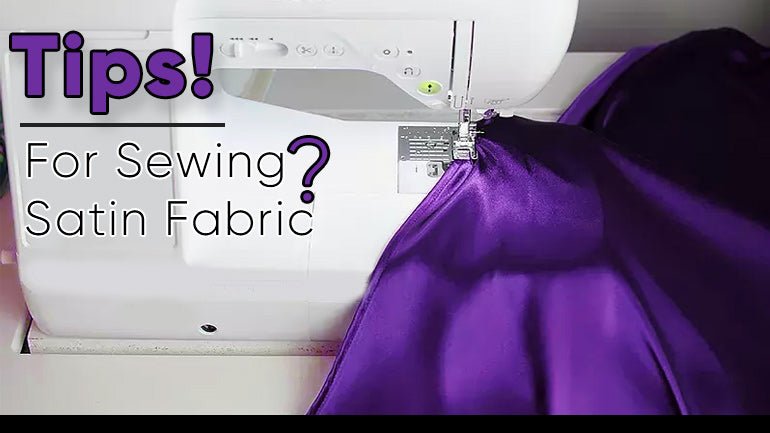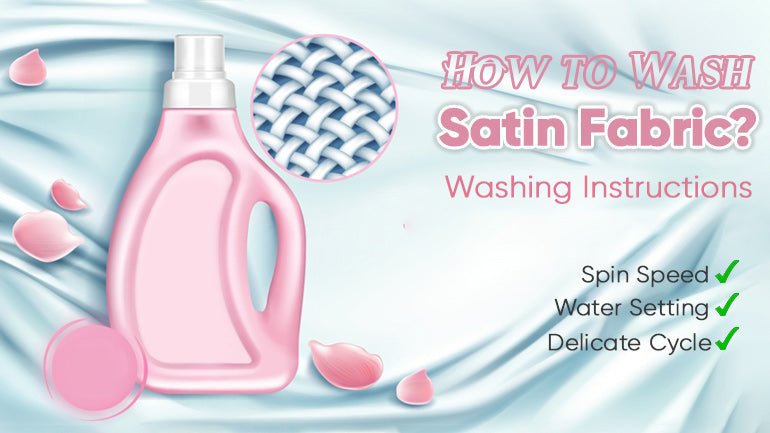Satin is a popular and versatile fabric, often used in a variety of garments, such as dresses, skirts, and lingerie. Its smooth and lustrous surface makes it an excellent choice for evening wear and formal occasions. However, despite its popularity, many sewers struggle with its unique characteristics. They often find it difficult to sew due to its slipperiness and tendency to fray. In this article, we will discuss whether sewing satin is hard and provide tips and tricks to make the sewing process easier.
Is Sewing Satin Hard?
The answer to this question is yes and no. Satin is a delicate and slippery fabric that requires a certain level of skill and patience to work with. Unlike cotton or wool, satin does not hold its shape, making it more challenging to sew and to keep the fabric from slipping. However, with the right techniques, anyone can master the art of sewing satin.
Must read on a complete guide about What is Satin Fabric.
Advantages of Sewing Satin
Despite the challenges, there are many advantages to working with satin. Its smooth and lustrous surface creates a beautiful drape and shines, making it perfect for elegant, high-end garments. Its versatility means that it can be used in a variety of applications, from dresses and skirts to lingerie and even home décor.
How to Sew Satin Fabric
Sewing satin fabric can be a little tricky due to its delicate and slippery nature, but with the right tools and techniques, it can be a satisfying and rewarding experience.
Tips for Sewing Satin Fabric on Sewing Machine
Materials and Tools:
Before you start sewing, you need to have the right tools and materials. The following is a list of items you will need to have on hand:
- Satin fabric
- Sewing machine
- Pins
- Scissors
- Sewing needles
- Sewing thread
- Tailor’s chalk
- Fabric glue
- Ruler
- Iron and ironing board
you can get a high-quality Satin by the yard from Ice Fabrics at a reasonable price.
Pre-Washing the Fabric
Pre-washing satin fabric before sewing is important as it helps to prevent any shrinkage or changes in the fabric’s structure that could affect the final result. It also helps to remove any sizing or chemicals that may have been applied to the fabric during the manufacturing process.
How to Pre-wash Satin Fabric
To pre-wash satin fabric, follow these steps:
- Fill a basin or sink with lukewarm water and add a gentle detergent or fabric softener.
- Place the satin fabric in the water and gently agitate it with your hands for a few minutes.
- Do not scrub or wring the fabric, as this can cause damage to the delicate satin fibers.
- Drain the water and rinse the fabric with fresh water until the water runs clear.
- Gently press the fabric to remove excess water, but do not wring it.
- Hang the fabric to air dry, or lay it flat on a clean towel. Avoid using a dryer, as heat can shrink and damage the satin.
- Once the fabric is dry, iron it on the lowest setting to remove any wrinkles.
- Your pre-washed satin fabric is now ready to use.
Get a deeper understanding of Satin Fabric Washing Instructions.
Cutting the Fabric:
When cutting satin fabric, it’s essential to use sharp scissors. This will prevent the fabric from fraying or tearing. To prevent the fabric from slipping, place a piece of tissue paper or interfacing under the fabric while cutting. This will give you a stable surface to cut on and prevent the fabric from shifting.
Marking the Fabric:
Use tailor’s chalk or fabric glue to mark the fabric. Satin fabric is delicate and prone to snagging, so it’s best to avoid using pins to mark the fabric.
Choosing the Right Needle:
When sewing satin, it’s important to choose the right needle. A universal needle or a microtex needle is recommended for sewing satin fabric. The needle should be sharp and small to minimize the risk of damaging the fabric. Do you know the sewing satin needle size? The appropriate needle size for sewing satin fabric depends on the weight and type of satin you are using. Here are some general guidelines:
- Lightweight satin: Use a size 9 or 10 needle
- Medium-weight satin: Use a size 11 or 12 needle
- Heavy-weight satin: Use a size 14 or 16 needle
It's always a good idea to test your needle and stitch length on a scrap piece of the same fabric you're working with before starting your project.
Stabilizing the Fabric:
Satin fabric is prone to shifting and slipping while being sewn. To prevent this, it is important to stabilize the fabric before sewing. This can be done by using interfacing, basting, or using a walking foot attachment for your sewing machine. A walking foot attachment helps to hold the fabric in place while it is being sewn, which results in straight seams and even stitches.
Sewing the Fabric:
When sewing satin fabric, it is important to use a longer stitch length to avoid piercing the fabric. A stitch length of 2.5 to 3.0 is recommended. Additionally, it is best to use a straight stitch rather than a zigzag stitch, as a zigzag stitch can cause the fabric to bunch and pull.
When sewing curves, it is important to go slow and carefully. To avoid stretching the fabric, it is best to stitch in the direction of the bias. This will help to maintain the fabric's shape and prevent the fabric from becoming distorted.
Finishing the Seams:
After sewing the seams, it is important to finish the edges to prevent fraying. This can be done by using a zigzag stitch, pinking shears, or an overlock machine. A zigzag stitch is a simplest and quickest method, but it can cause the fabric to bunch. Pinking shears are a great option if you do not have an overlock machine, as they help to prevent fraying while also providing a clean and finished edge. An overlock machine is the best option for a professional finish, as it trims and overcasts the edges in one step.
Sewing Techniques for Satin Fabric
Satin fabric is slippery and delicate, so it requires special sewing techniques to prevent any damage or fraying. The following tips will help you achieve a professional-looking finish when sewing satin fabric.
- Use a Walking Foot: A walking foot is a presser foot that moves the fabric through the sewing machine evenly. This is especially important when sewing satin fabric, as it helps to prevent any stretching or bunching of the fabric.
- Sew with a Straight Stitch: Satin fabric frays easily, so it is best to sew it with a straight stitch. This stitch is stronger and will help prevent any fraying or damage to the fabric.
- Adjust the Tension: Satin fabric is delicate, so it is crucial to adjust the tension of the sewing machine accordingly. Start with a low tension setting and gradually increase it until you achieve the desired stitch length. This will help prevent any damage to the fabric, especially when using a walking foot.
- Use a Pin Cushion: Using a pin cushion can help prevent any damage to the fabric while pinning. It is best to use fine, sharp pins when pinning satin fabric, as they will not leave any marks on the fabric.
- Slow Down: Satin fabric is delicate, so it is important to slow down when sewing. This will help prevent any damage to the fabric, especially when using a walking foot.
Expand your knowledge on Satin vs Silk.
How do you Stop Satin Puckering when Sewing?
If you want to prevent satin from puckering while sewing, it is important to start with a properly threaded machine with a sharp needle and a tension that is appropriate for the fabric. Satin tends to be slippery, so it is best to use a walking foot to help guide the fabric through the machine. Avoid stretching the fabric while sewing, and keep the fabric layers smooth. Also, using a fabric stabilizer like fusible interfacing can help prevent puckering. Before sewing, make sure to pre-wash and iron the satin fabric to remove any wrinkles or shrinkage. Proper pressing and pinning techniques also help keep the fabric smooth and prevent puckering.
Faqs
Should you wash satin before sewing?
Yes, It is generally recommended to wash satin fabric before sewing with it. This helps to preshrink the fabric, remove any sizing or finishes, and ensure that the fabric will not shrink or change shape during future washings. Washing also helps to soften the fabric and improve its draping qualities.
Can you use a sewing machine on satin?
Yes, you can use a sewing machine on satin fabric. However, satin is a delicate and slippery fabric, so it is important to use the appropriate needle, thread, and settings for your sewing machine. A ballpoint needle or a special satin needle is recommended, as these types of needles will not damage the fabric or leave holes. It is also a good idea to use a silk or polyester thread, as cotton thread can leave lint on the fabric. When sewing, you may need to adjust the tension or foot pressure, or use a walking or Teflon foot, to ensure that the fabric feeds through the machine smoothly and without puckering.
What is the best stitch for satin fabric?
The best stitch for satin fabric is a straight stitch or a narrow zigzag stitch. A straight stitch will provide a clean and crisp edge, while a narrow zigzag stitch will prevent the fabric from fraying. To achieve the best results, it is recommended to use a satin stitch foot and a fine-tipped needle. Additionally, using a fabric stabilizer can help to prevent slipping and ensure a smooth, even stitch.
How do you get satin stitch neat?
To get a neat satin stitch, it is important to keep the stitches close together and maintain a consistent stitch length. Start by pulling the needle up at the beginning of the stitch and then down at the end without pulling the thread too tight. To avoid puckering, loosen the fabric a bit before making the next stitch, and make sure to anchor the threads properly. Regularly check the back of your work for any loose threads and correct them as needed. To achieve a smooth finish, use the right size of needle and a high-quality thread that matches the fabric.
How to cut satin fabric without fraying?
To cut satin fabric without fraying, use pinking shears or a serrated blade, or seal the edges with the fray-preventing solution or a zigzag stitch.
How do you keep satin from slipping when sewing?
To cut satin fabric without fraying, you should use sharp fabric scissors or rotary cutters and a cutting mat. Before cutting, ensure that the fabric is well pressed and then fold it neatly. Start by making a straight line with a fabric pencil or tailor's chalk, then place the fabric on the cutting mat and cut along the line using sharp scissors.
Does satin tear easily?
Satin fabric is known for its smooth and silky texture, but it can be quite delicate and susceptible to tearing. This is due to the weave of the fabric, which is composed of very fine threads that are tightly woven together. This makes the fabric more susceptible to snagging and tearing, especially when it is pulled or stretched. Additionally, satin is often made from delicate fibers like silk, which can also make it prone to tearing. To prevent tears, it is important to handle satin carefully, avoiding sharp objects and rough surfaces, and to store it properly, avoiding any excessive folding or compression. Overall, while satin can be beautiful and luxurious, it requires special care to ensure its longevity.



